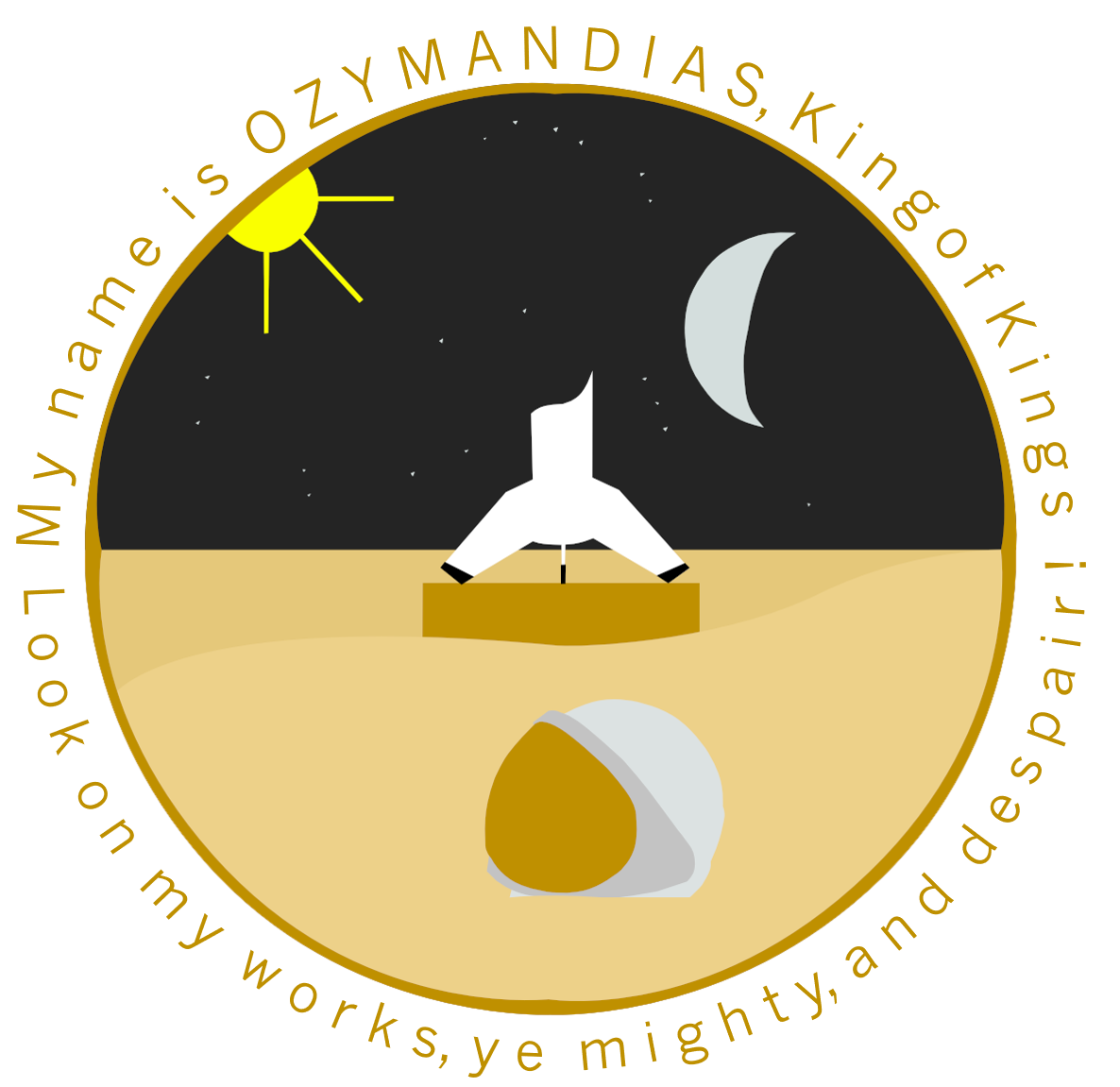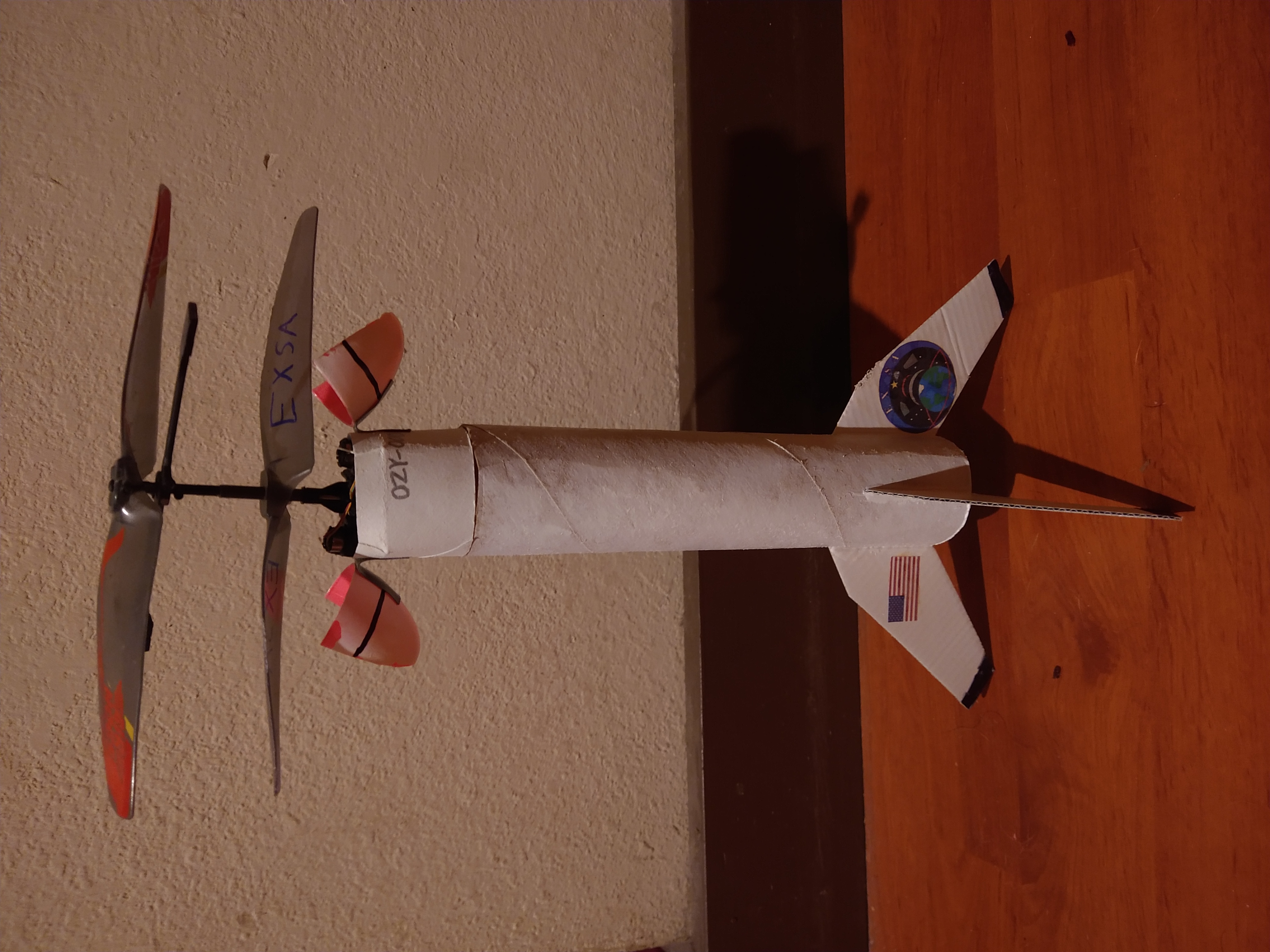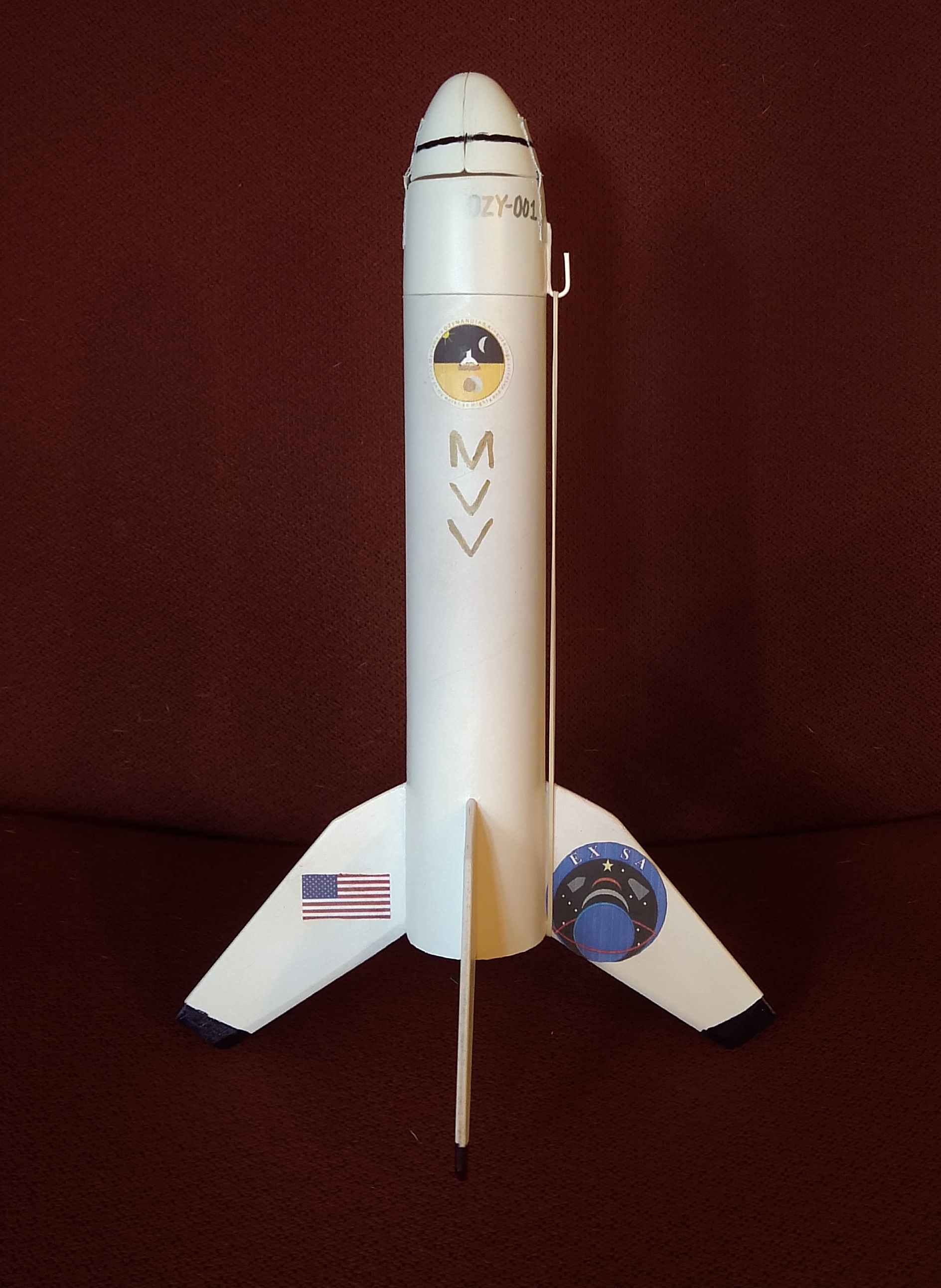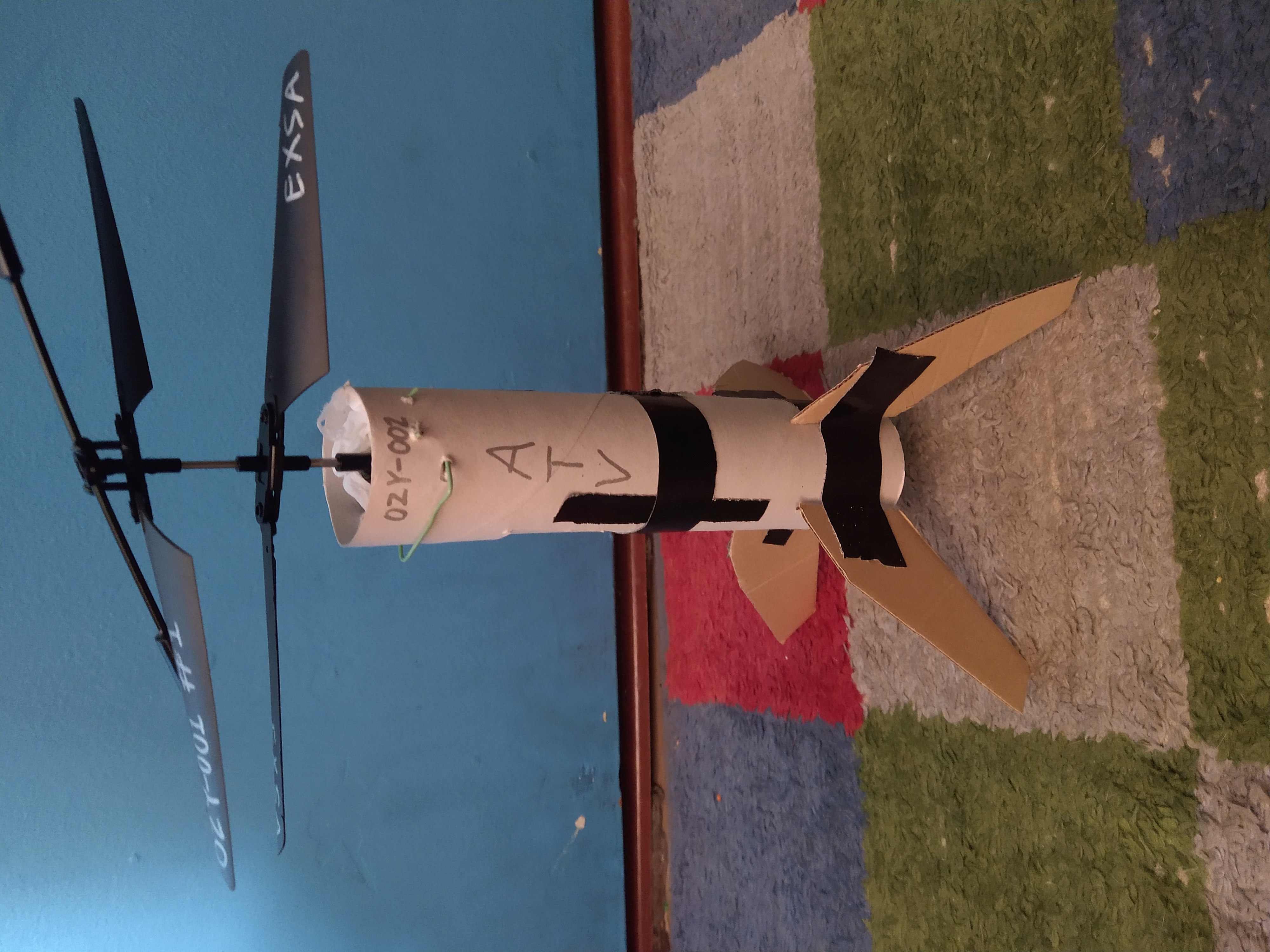
Project Ozymandias is my plan to validate powered helicopter recovery of a rocket with a functioning model rocket design that is capable of helicopter take-off, mid-air launch, payload deployment and a helicopter soft landing within mission parameters and launch it successfully multiple time to prove it is practical. This has never been tried before, the closest being attempts at propulsive retro-rocket landings, which I believe are more difficult for model rockets. I also would like to develop a Return-to-Launch-Site (RTLS) version and a helicopter takeoff, mid-air ignition (HTMI) version in the future. Ozymandias is different from auto-rotation recovery, which is commonly refered to as helicopter recovery.

Inspired by Shadow Zone's "Ozymandias" KSP series, especially the first video in which he reads the poem by Percy Bysshe Shelley, which his series is ultimately based on. I was inspired by the Ozymandias VIII spacecraft, it's outside-the-box thinking in the design and operation, mainly the idea of landing the entire ship on small moons to mine fuel instead of a mining lander, all while having a cool-looking yet practical rocket. I hope to replicate the "outside-the-box" thinking paired with coolness factor with the quad drone recovery of my own Ozymandias. The music Rites by Kevin Macleod is royalty free and used in that video as the theme of his spacecraft, and I may even use it as my Ozymandias theme.
The poem itself by Shelley is a reminder that even the greatest ambitions on Earth won't stand the test of time, let alone eternity. So, although I get excited in this project and hope to achieve great things, I must remember they are here today and gone tommorrow, and fall short compared to eternal concerns of more importance.
Before actually building anything, I suspected that radio controller range, deployment, aerodynamic covers for the propellers during ascent, and weight/aerodynamic stablity will be the primary problems to tackle.
At some point during pre-dev, I decided to search the internet to see if what I wanted to do had already been done, as I was operating under the impression it hadn't. The only thing I could find was a series of videos on youtube by a user named RC Lover san which used parts from a drone to make a vertical landing after launch. He calls it simply his "Rocket Drone" but it has "HAWK-1" written on the pyrotechnic propulsion module. At first I was a bit disapointed, but then I realized that he had only made successful flights under water-powered rockets and his only (to-date) pyrotechnic rocket was unable to land successfully, in fact entering a ballistic trajectory and landing in a tree. he has since restored it and flown it around, but hasn't attempted to launch it again. So, it still hasn't been done. The big difference between his rocket and mine are that his rocket's drone propellers are unshethed outside the main body tube in the airflow, while mine will be inside the body tube or fairing and pop out at apogee.I am subscribed to his channel and hope that he continues development of his rocket drone, however I hope to set a record for first successful pyrotechnic model rocket recovery under powered helicopter blades.
OZY Triple Zero (OZY-000), or the Mock-up and Engineering Pioneer (MEP), is not an actual flying rocket and is primarily a mockup to show what the final product will look like, but I also hope to validate that the propeller motor can be fit inside the Baby Bertha 1.64'' (42mm) body tube/nosecone. If not, I would have to construct a custom nose cone capable of houseing it. This would give is a bit of a New Shepard look. The motor used here (that from an AirHogs AXIS300X) fits inside just barly with some plastic mounts having to be shaved off.

I started work on the Modification Validation Vehicle (OZY-001), or the MVV for short, on March 1st, 2022. The Baby Bertha kit used for OZY-001 was a Christmas present and was originally going to be Project Newcomer rocket and join in similarity tests with Newcomer 3 and Newcomer 5 to test the differences inbetween rocket kits.
Its original purpose was to test the stability of the Ozymandias rocket design during ascent and as many other modifications to the Baby Bertha model as possible with out actually attempting a propeller recovery. This is similar in function to how the Gemini program was designed to test out as many skills and systems as possible for Project Apollo with out actually going to the Moon.
However, at the March 2022 SRA launch I talked with a rocketeer there and learned about a rocket design and flight simulation program called OpenRocket. I had only heard of RockSim, which is over $100 and my budget, so I had decided not to try and simulate the Ozymandias' stability on a computer and just build one to launch. However, he told me OpenRocket was free and had mostly all the same features that RockSim had. I told him I would definetly try that out when I got home. I hadn't finished building OZY-001 yet at the time of the launch, I hadn't installed the propeller motor mass simulator yet. So, the next day I was thinking about it and decided that before I finished it as a "Modification Validation Vehicle", I would check out OpenRocket. If I could prove it was stable on the simulation, I might skip a "Modification Validation Vehicle" since the simulation already validates the modifications. The I would just use OZY-001 as Ozymandias I and install a real propeller into it.

Over the course of the following month, I did download OpenRocket and read some tutorials on the wiki about how to use it, and made a model of my MVV. I haven't learned all the features yet, but I think it is safe to say it flies fairly stable. So, this would essentially negate the need for an MVV, at least I thought. I decided to build OZY-001 as Ozymandias I and install a real propeller in it and attempt a powered recovery using it. However, these plans would not last long.
In early April, I returned to the idea of making OZY-001 an MVV. Shortly after earning my Freedom Award, our patrol started working on the model rocketry elective badge, but at the time I didn't know I could still earn the badge unofficially. I still attended all those meetings out of interest though, so I got all the requirements for the badge that we need then.
To complete the badge now, all I would need to do outside what I have done up to this point at Trail Junction and SRA launches is design, build and launch my own rocket. Although OZY-001 is actually just an Estes Baby Bertha, I changed the fin shape and designed the entire rocket with those modifications in OpenRocket, (which is actually mentioned in the badge. It was right under my nose!) I think that if I also make the "fairing" modifications to the nosecone I have in mind that it would count as designing, building my own rocket, even though the fairings cannot be accurately represented in OpenRocket. For this reason, I have decided to attempt to complete OZY-001 as an MVV, not just for the original reasons but also to earn the Trail Life Model Rocketry elective badge in time for the award ceremony.
However, I made a slight change in plans again in late April. I realized that the MVV is identical to the final Ozymandias phase 1 design except for the ejection piston/propeller unit. If I could remove the mass simulator and parachute after the test flight, I could just reuse the same rocket. This would save alot of time, as sanding and gluing the rocket together takes time. But bcause of the taper of the nose cone the width of the shoulder, once I glued the nosecone in place, I couldn't add an ejection piston; it wouldn't fit in. I knew there had to be some way around this.
I realized that if instead of gluing the nosecone on, I made it detachable somehow, I could use the same rocket to test the parachute, ejection piston and final propeller recovery all on the same rocket, but progreesivly and not at the same time. I developed a hook system with a rubbarband to keep the nosecone in place during flight, but that I can easily remove. This is when I canceled plans for the Ejection Piston Test Vehicle "EPTV" (OZY-002) rocket, which would have been the same rocket as the original MVV, but with the piston inplace and the parachute attached to that. Now, I will simply add a piston with a paracute to the MVV and fly the "EPTV" test there, and finally add a piston with a propeller for the final test.
This new design for the MVV will allow me to more rapidly perform iterative tests of the Ozymandias vehicle, since the only real change will be to the piston unit, and possibly the nosecone, both of which are removable and replaceable now.
While thinking about thos, I realized that this means that the MVV is really more like Ozymandias I then simply an MVV. I considered changing the name, but I had already written the name on the rocktet by the time I decided I thought that made more sense. The nomenclature dosen't make as much sense anymore either, since it is 'OZY-001' with the first zero meaning it is a prototype, when it will actually become a full flight vehicle eventually. However, I have decided to call my next rocket (OZY-101) Ozymandias II. I was origianlly planning for this to be the first propeller-enabled rocket, but since the MVV will do that now, it really won't be the 'first' at anything, so it is really Ozymandias II and the MVV is Ozymandias I.

On May 1st, I bought two "Sky Transporter" remote control heli-car toys from Five Below. The brand name is "XB" or XIB" but it appears to be a Five Below in-house brand, because I can only find it on their website here. They cost $5 each. I test flew one of them and it seemed pretty capable, however there were a few problems. First, it is controled by an infared signal, not radio, which means that outside in the sun their will be interference. Also, the controller must be pointing at the copter or it will not recieve any signal. The blades have a hinge in them that rotates along the plane of rotation of the rotors, which allows them to snap back out of the way of obstacles they hit with out straining the engine.
That night, I quickly built a model of an ozymandias rocket using cardboard and removed the propeller and electronics from the "Sky Transporter" toy. I then made a jeririgged mount out of a paperclip and some tissue paper wadding for the propeller in the cardboard model and put it in. I called it the Atmospheric Test Vehicle (OZY-002) or the ATV for short. That night I tried to test fly it, but it was not able to lift off straight because my mounting mechanism could not keep the propeller straight, so it had an off-center thrust vector and crashed, which made the propeller all the more loose.
The next night, I made some modifications, including a mass simulator and a second paperclip going perpendicular to the other one to keep it straight. This helped alot, but it still went off to the side, possibly because the cardboard fins were not straight, or it caught on the floor, or any other reason. However, my brother Adam Boersma had the idea to start with it in the air and drop it. This made perfect sense, as the actual Ozymandias will not be taking off either, but landing while already in the air. When we tried this, it worked much better. In fact, it came done quite slow and stable, but toppled over due to some horizontal velocity.
The ATV seemed to work pretty well and apparently proved that the propeller could support the Ozymandias vehicle. However, in the next month there would be other problems to solve.

Around this time OZY-001 was nearing completion. I had mostly finished the ejection piston and all that was left was to install the shockcord/parachute and it would be ready for flight. However, I realized that the paarchute would most likly not deploy because of the inside shape of the fairings, which would cause a failure of the flight. The nosecone is hollow, so the fairing halves are fairly concave on the inside, which might mean the parachute gets caught my them instead of pushing them out of the way. I was thinking of putting a back into them to make the parachute have a more smooth surface to slide across, but I realized this would mean I could not add any magnets inside the fairings to help keep them shut/open as I had been considering. So, I would have to add them now, before I add the backing. However, I don't have any magnets of this size and I don't know if I can get them and install them before the May SRA launch. Because of our upcoming vacation, this means I will miss both the June and July launches. Technically, I could launch it myself in Yellow Park though.
The main concern is not this, but that I don't even know if th magnets will work. the fairing halves may get in the way of the propellers and hit them. Also, the hook for using the rubberband to keep the nosecone on is right where one of the magnets to keep the nosecone opebn would have to be. I could try to remove it and there IS another place where it could be put, but it might not attach as stringly to the now painted surface. All of this is not a concern for the parachute version, which does not need the fairings to be fully down, all it needs is the fairing backings. However, in order to use the MVV as the first propeller vehicle, I would need to add the magnets and move the hook first. The solution, then would be to return to the original idea of OZY-001 being an MVV only and the next rocket OZY-101 being the first to use a propeller. However, although I have gotten better at modifiying the Baby Bertha kit to be Ozymandias, it would still take time to build the new rocket
Amid this change, I have also considered other problems, like the range of the controller, it's ability and reliablity to work outdoors in the sun (it uses UV rays) and the ability of the vehicle to rotate upright after deployment at apogee, which I assumed the change in the center of pressure would do, but the center of mass will also move towards the front, and if the propellers haven't started spinning yet, then they might fold up again or get stuck. The propellers muight not even be enough to change the center of pressure enough, I don't know! And that is just it; I don't know. I haven't properly designed the deployment of the propellers with Ozymandias, I just thought it through and it sounded good so I started building it. Okay, it wasn't that bad, but I didn't do a good job of designing it. It also uses a kit and a toy's propeller, so I spend alot of time simply adapting these things to my use, instead of having my own rocket and on propeller. I really should be using my own electronics for this. This brings me to what had happened.

As I continued work on OZY-001 and THM001, I became more interested in Thrust Vectoring Control (TVC) for rockets. I was inspired by both youtuber BPS.space and my new to-be-roommate Cade Neely's engineering efforts. I decided to turn Project Theremin from simply my first homemade rocket and small project platform to addionally a single rocket family that I will perform modifications to, starting with TVC and dual deployment electronics. The reason I am putting this here is that I have even envisioned a version of Theremin that could have a propeller for landing, and esentially blend Ozymandias and Theremin together as one project. This would solve the aforementioned problems with the Ozymandias design, which is small, uses very basic and non-flexible parts from kits, was not properly designed and has a high chance of not working at all. Instead of making a new Ozymandias rocket, I could temporarily shelf the helicopter landing endeavour and focus on a different new rocket, Theremin, which would be done properly and eventually come to a helicopter recovery.
This is why Project Theremin is officially becoming my primary concern, or flagship project. I will still work on Ozymandias vehicles in preparation for the final helicopter Theremin design, however Ozymandias will simply be more of a test platform and will not actually perform all of the goals originally envisioned (RTLS, mid-air ignition) and instead Theremin will pursue these in later stages. I think that despite putting helicopter recovery on hold for awhile, this is the best way to progress my engineering and rocketry skills and to evetually achieve a successful and proper helicopter recovery of a model rocket.
With this new goal in mind, I realized that that I could simply make the nosecone from my next Baby Bertha, which I already bought, into an Ozymandias fairing pair with proper hook, magnet and backing placement and simply put it on the MVV for testing. Then I could simply make the body of the new Baby Bertha with any adjustments needed, and use the ejection piston and it's own nosecone from the MVV. I could also just keep the second rocket unconstructed for spare parts. This frees me up to simply add backing to the MVV's nosecone and not try and add magnets or move the hook, etc. This also means I will be able to meet the requirements for the Trail Life model rocketry badge in time.
I successfully flew the MVV at the May SRA launch, and it didn't go as planned. It didn't even fail in a way I anticipated. The parachute came out fine, but the ejection force caused the ejection piston to snap the rubber band and lodge itself in the nosecone and push it out of the body tube. The body tube and fins fell separatly from everything else, but both were undamaged. The aluminum foil on the bottom of the ejection piston worked great, and other then the rubberband snapping and the ejection piston being bent up a bit on top the MVV could launch again. The good news is it counted for the launch I needed for the Model Rocketry Trail Life badge, yea!
I plan to fix the problem by using something stronger like fishing line or striing to secure the nosecone and reinforcing the top of the piston and adding a thicker border to it as well as the bottom of the nosecone so that it won;t get lodged inside again and will actually stop. Perhaps even adding some padding to slow it down.
| Name | Designation | Model | Notes | Status |
|---|---|---|---|---|
| MEP | OZY-000 | Custom (Baby Bertha Mockup) | The Mock-up and Engineering Pioneer is not a real rocket and exists purly as a visual represntation of the final design. Possibly testing some basic construction techniqies for propeller deployment in the future. | Mock-up |
| MVV | OZY-001 | Estes Baby Bertha | The Modification Validation Vehicle will test the added weight and fin adjustments to the Baby Bertha, and then be modifed for first attempt at powered drone recovery. 0.o | Active |
| ATV | OZY-002 | Custom (Baby Bertha look-a-like) | The Atmospheric Test Vehicle tested the ability of the propeller to handle the shape and weight of the Ozymandias vehicle in flight. | Retired |
| Ozymandias I | OZY-101 | Estes Baby Bertha | Second attempt at an actual flight vehicle with quad prop installation and landing. | Kit Aquired |
More Ozymandias rockets will be built as they are determined they are needed.
Updated on 5/17/2022 by William Boersma